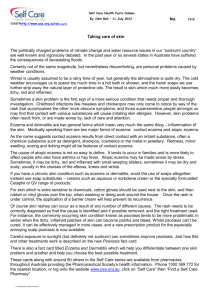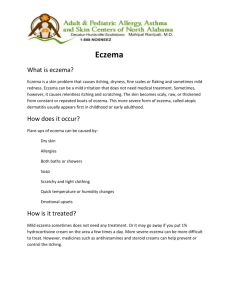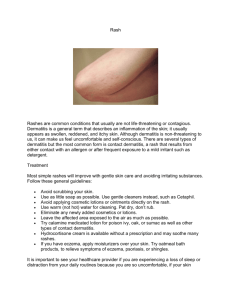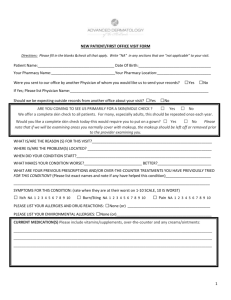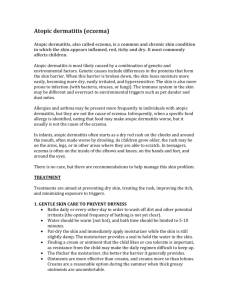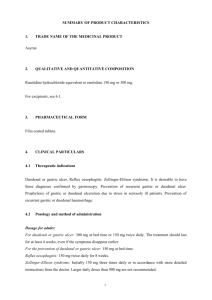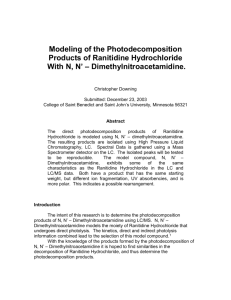patients and methods - Kalbe Medical Portal
advertisement
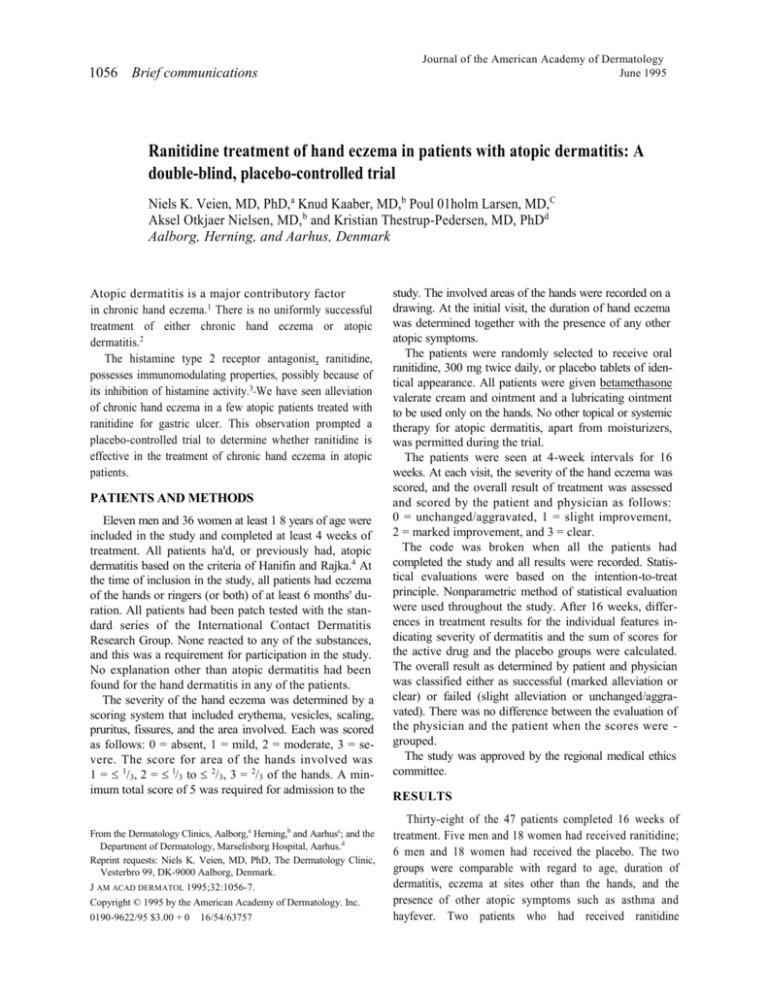
1056 Brief communications Journal of the American Academy of Dermatology June 1995 Ranitidine treatment of hand eczema in patients with atopic dermatitis: A double-blind, placebo-controlled trial Niels K. Veien, MD, PhD,a Knud Kaaber, MD,b Poul 01holm Larsen, MD,C Aksel Otkjaer Nielsen, MD, b and Kristian Thestrup-Pedersen, MD, PhDd Aalborg, Herning, and Aarhus, Denmark Atopic dermatitis is a major contributory factor in chronic hand eczema.1 There is no uniformly successful treatment of either chronic hand eczema or atopic dermatitis.2 The histamine type 2 receptor antagonist, ranitidine, possesses immunomodulating properties, possibly because of its inhibition of histamine activity.3 We have seen alleviation of chronic hand eczema in a few atopic patients treated with ranitidine for gastric ulcer. This observation prompted a placebo-controlled trial to determine whether ranitidine is effective in the treatment of chronic hand eczema in atopic patients. PATIENTS AND METHODS Eleven men and 36 women at least 1 8 years of age were included in the study and completed at least 4 weeks of treatment. All patients ha'd, or previously had, atopic dermatitis based on the criteria of Hanifin and Rajka.4 At the time of inclusion in the study, all patients had eczema of the hands or ringers (or both) of at least 6 months' duration. All patients had been patch tested with the standard series of the International Contact Dermatitis Research Group. None reacted to any of the substances, and this was a requirement for participation in the study. No explanation other than atopic dermatitis had been found for the hand dermatitis in any of the patients. The severity of the hand eczema was determined by a scoring system that included erythema, vesicles, scaling, pruritus, fissures, and the area involved. Each was scored as follows: 0 = absent, 1 = mild, 2 = moderate, 3 = severe. The score for area of the hands involved was 1 = 1/3, 2 = l/3 to 2/3, 3 = 2/3 of the hands. A minimum total score of 5 was required for admission to the From the Dermatology Clinics, Aalborg,a Herning,b and Aarhusc; and the Department of Dermatology, Marselisborg Hospital, Aarhus.d Reprint requests: Niels K. Veien, MD, PhD, The Dermatology Clinic, Vesterbro 99, DK-9000 Aalborg, Denmark. J AM ACAD DERMATOL 1995;32:1056-7. Copyright © 1995 by the American Academy of Dermatology. Inc. 0190-9622/95 $3.00 + 0 16/54/63757 study. The involved areas of the hands were recorded on a drawing. At the initial visit, the duration of hand eczema was determined together with the presence of any other atopic symptoms. The patients were randomly selected to receive oral ranitidine, 300 mg twice daily, or placebo tablets of identical appearance. All patients were given betamethasone valerate cream and ointment and a lubricating ointment to be used only on the hands. No other topical or systemic therapy for atopic dermatitis, apart from moisturizers, was permitted during the trial. The patients were seen at 4-week intervals for 16 weeks. At each visit, the severity of the hand eczema was scored, and the overall result of treatment was assessed and scored by the patient and physician as follows: 0 = unchanged/aggravated, 1 = slight improvement, 2 = marked improvement, and 3 = clear. The code was broken when all the patients had completed the study and all results were recorded. Statistical evaluations were based on the intention-to-treat principle. Nonparametric method of statistical evaluation were used throughout the study. After 16 weeks, differences in treatment results for the individual features indicating severity of dermatitis and the sum of scores for the active drug and the placebo groups were calculated. The overall result as determined by patient and physician was classified either as successful (marked alleviation or clear) or failed (slight alleviation or unchanged/aggravated). There was no difference between the evaluation of the physician and the patient when the scores were grouped. The study was approved by the regional medical ethics committee. RESULTS Thirty-eight of the 47 patients completed 16 weeks of treatment. Five men and 18 women had received ranitidine; 6 men and 18 women had received the placebo. The two groups were comparable with regard to age, duration of dermatitis, eczema at sites other than the hands, and the presence of other atopic symptoms such as asthma and hayfever. Two patients who had received ranitidine Journal of the American Academy of Dermatology Volume 32, Number 6 and seven who received the placebo left the study because of aggravation of their dermatitis. The total score was reduced from a mean of 10.17 to 4.91 in the group who received ranitidine and a topical steroid, compared with a reduction from a mean of 10.58 to 7.46 in the group who received a placebo and a topical steroid (p = 0.07, Kruskal-Wallis test). Score reduction was most pronounced during the first 4 weeks of therapy. The score continued to decrease for the group treated with ranitidine during the next 12 weeks, whereas it remained nearly constant for the group that received the placebo. Assessment of the individual features showed that those receiving ranitidine had a statistically significant reduction in area of involvement after 16 weeks (p - 0.02), whereas differences in favor of ranitidine for the reduction of erythema (p = 0.15), scaling (p = 0.15), pruritus (p = 0.12), fissures (p = 0.08), and vesicles (p = 0.65) were not statistically significant. The eczema of 17 of 23 patients treated with ranitidine cleared or had been markedly alleviated, compared with that in 8 of 24 patients who received placebo. The difference between the two groups is statistically significant (p = 0.02, Fisher's exact test). There were no side effects from either ranitidine or placebo. DISCUSSION The results of this study indicate that as an adjuvant to a topical steroid, ranitidine is more effective than a placebo in reducing the signs and symptoms of atopic hand eczema. Although the differences between the effect of ranitidine and the placebo were not statistically significant for all measurements, the group treated with ranitidine did consistently better. The smallest difference between the active drug and the placebo group was seen for "number of vesicles." In retrospect, this feature should probably be reserved for determination of the efficacy of treatment of palmar and interdigital eczema because vesicles occur in dorsal hand eczema only in very acute dermatitis. In fact, calculation of the total score of all features showed a statistically significant difference between active treatment and placebo if "vesicles" was omitted (p = 0.05, Kruskal-Wallis test). The score reduction seen during the first 4 weeks Brief communications 1057 for both groups of patients was probably primarily from the effect of betamethasone. During the subsequent 12 weeks, the difference between the two groups increased. The treatment period should perhaps have been longer than 16 weeks because the group treated with ranitidine continued to improve during the entire study period. Ranitidine has an immunomodulatory effect. This has led to studies of its effect in trauma, neo-plastic diseases, and autoimmune diseases.3,5 Ranitidine also appears to be effective as monotherapy in some patients with treatment-resistant psoriasis.6,7 The mechanism by which ranitidine acts in this disease remains speculative. Possible mechanisms include the blocking of H2 receptors presented by immunoactive cells as a part of the inflammatory process8 and an antioxidative action.9 These mechanisms may be operative in atopic hand eczema. REFERENCES 1. Meding B, Swanbeck G. Epidemiology of different types of hand eczema in an industrial city. Acta Derm Venereol (Stockh) 1989;69:227-33. 2. Moller H. The atopic hand eczema. In: Menne T, Maibach HI, eds. Hand eczema. Boca Raton: CRC Press, 1993:43-8. 3. Nielsen HJ, Hammer JH. Possible role of histamine in pathogenesis of autoimmune diseases: implications for immunotherapy with histamine-2 receptor antagonists. Med Hypotheses 1992;39:349-55. 4. Hanifin JM, Rajka G. Diagnostic features of atopic dermatitis. Acta Dermatol Venereol Suppl (Stockh) 1980;92:44-7. 5. Nielsen HJ. Role of histamine in the pathogenesis of autoimmune disease: implications for drug therapy. Clin Immunother 1994; 1:250-7. 6. Nielsen HJ, Nielsen H, Georgsen J. Ranitidine for improve ment of treatment resistant psoriasis [Letter]. Arch Derma tol 1991;127:270. 7. Witkamp L, Velthuis PJ, Verhaegh MEJM, et al. An open prospective clinical trial with systemic ranitidine in the treatment of psoriasis. J AM ACAD DERM ATOL 1993;28:77881. 8. Nielsen HJ. Histamine and histamine type 2 receptor antagonists in psoriasis: mechanisms and speculations. Dan Med Bull 1991;38:478-80. 9. Nielsen HJ, Nielsen H, Jensen S, et al. Ranitidine improves postoperative monocyte and neutrophil function. Arch Surg 1994;129:309-15.

